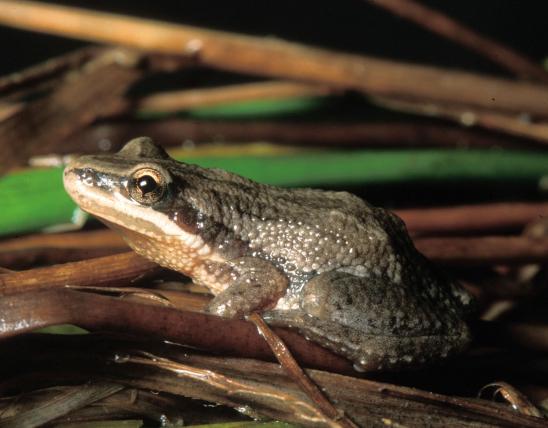
The upland chorus frog is a small gray or tan frog with dark stripes on the back that are narrow or broken into a series of dashes or spots. Some frogs may lack such markings. An irregular gray stripe extends from the snout through the eye and down each side to the groin. A dark spot on the head between the eyes may be triangular. The belly is white. Breeding males have dark throats.
The breeding call of males is similar to that of the closely related Cajun chorus frog (Pseudacris fouquettei) and boreal chorus frog (Pseudacris maculata). All three sound like a fingernail running down the tines of a pocket comb. The upland chorus frog call is a clicking trill or “crrreeeeek,” with a rising inflection as it ends. It is difficult to distinguish the upland chorus frog call from the boreal chorus frog call. The boreal chorus frog sounds slightly raspier or more metallic. Both the upland chorus frog and boreal chorus frog have a noticeably faster call rate and a shorter call length than the Cajun chorus frog.
Similar species: In the hylid family, nine species, in three genera, are native to Missouri:
- Acris, the cricket frogs, one species: Blanchard’s cricket frog;
- Hyla, the treefrogs, three species: gray treefrog, Cope’s gray treefrog, and green treefrog; and
- Pseudacris, the chorus frogs, five species: spring peeper, upland chorus frog, Cajun chorus frog, Illinois chorus frog, and boreal chorus frog.
The upland chorus frog is very similar to the Cajun chorus frog and the boreal chorus frog. The three can be distinguished by genetics, color patterns, slight differences in calls, and distribution.
The distribution of the upland chorus frog and the Cajun chorus frog in Missouri is not well understood. The upland chorus frog seems to occur mostly within the Mississippi Lowlands of extreme southeastern Missouri, but on its western edge, the range apparently overlaps with that of the Cajun chorus frog. On its northern edge, it also might overlap with the boreal chorus frog.
It is possible that previous records of frogs identified as upland chorus frogs from the southeastern Ozarks are actually Cajun chorus frogs. It is also possible that upland chorus frogs only occur in the Mississippi Lowlands of extreme southeastern Missouri. Additional genetic studies are needed to better understand the boundaries of these three species, especially in areas where the ranges overlap.
Adult length (snout to vent): ¾ to 1½ inches. Females are larger than males.

Southeastern Missouri, including the southeastern Ozark Highlands as well as the Mississippi Alluvial Basin.
Habitat and Conservation
In Missouri, the upland chorus frog usually lives in small patches of woods, forested swamps, and river bottomland forests, especially near wetlands. They typically stay close to wooded areas but will cross open crop fields to seek breeding wetlands if necessary. Upland chorus frogs take shelter under leaf litter, under small logs or tree bark lying on the ground, or in small animal burrows during the day. These frogs are seldom seen outside of breeding season, when they are most active on damp nights as they search for prey.
Food
This species hunts for a variety of small insects and spiders, especially during damp nights.
Status
Common. Apparently it hybridizes with the boreal chorus frog where their ranges overlap.
Life Cycle
In Missouri, upland chorus frogs become active in February. They breed in late winter or early spring; most breeding activity is in March. Rainfall stimulates breeding. These may be the first frogs to chorus in southeastern Missouri.
Breeding occurs in temporary pools, flooded crop fields, ditches, and other shallow-water areas, especially in or near forested habitat. If necessary, upland chorus frogs will move through large, open areas such as grasslands or crop fields to reach breeding sites.
Males often sing in the water with their head and forelegs above the water, grasping a plant stem. Females lay 200–500 or more eggs, in small, elongated clusters of 40–60 eggs. They may lay two clutches per breeding season. Eggs usually hatch within a week. Transformation from tadpoles to froglets takes 6–10 weeks. Males become sexually mature within one year, while females often take up to two years.
Human Connections
These frogs help control populations of troublesome insects; also, because they are sensitive to pollutants, they are an indicator species whose health and population numbers help us to gauge the health of their ecosystem.
Chorus frogs and spring peepers are some of the earliest signs of spring in Missouri. After a long winter, it's wonderful to step outdoors at night and hear their welcome calls echoing from the woods.
Ecosystem Connections
These small frogs prey on numerous insects and spiders, helping to control their populations, but they also fall prey to many larger predators at each stage of their life cycle. There is even a documented instance of a spotted fishing spider turning the tables by eating an upland chorus frog. No doubt the adults and tadpoles are eaten by predaceous diving beetles and giant water bugs, too.






























